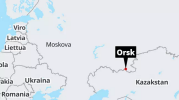03/29/2024, 00:01
1K7 min.
Fear has high prices
The Russian fuel market is afraid of shortages
Against the backdrop of the shutdown of a number of refining capacities at refineries, the government is trying to prevent a fuel shortage in Russia. The first step was a ban on gasoline exports. The second could be organizing priority transportation of petroleum products by rail and providing companies with tanks. Experts believe that this, in theory, could help stabilize the situation on the market, but much will depend on the final timing of planned and unscheduled repairs at factories.
Photo: Viktor Korotaev, Kommersant
The main task of the state and the Russian fuel and energy complex over the past two months has been to provide the domestic market with a sufficient amount of fuel. And so far it has succeeded. As reported by the Ministry of Energy, in March, gasoline shipments to Russian consumers showed an increase of 13 thousand tons per day compared to February (up to 794 thousand tons), diesel fuel - by 15.5 thousand tons per day. At the same time, according to the Central Dispatch Department of the Fuel and Energy Complex, in mid-March the volume of supplies exceeded the volume of production for the first time since September 2023. During the week of March 13–19, it fell by 3.9% relative to the previous week and by 5.2% relative to the planned level - to 779.4 thousand tons (111.3 thousand tons per day). Oil companies were able to cover the difference between these values using accumulated reserves of petroleum products, which as of March 22 amounted to 1.9 million tons of gasoline and 3.4 million tons of diesel fuel.
A blow to primary processing
The risk of a fuel shortage has arisen due to the shutdown of refining capacities at a number of plants. The first to fail at the very beginning of the year was the catalytic cracking unit at one of the largest Russian sites - the Nizhny Novgorod Oil Refinery of LUKOIL (capacity - 200 thousand tons per month). The reason was the breakdown of foreign compressor equipment, which cannot yet be replaced due to Western sanctions. According to authorities, finding an alternative and repairing it will take from several months to a year and a half. In the next two months, accidents due to drone attacks occurred at LUKOIL's Volgograd Refinery, Rosneft's Tuapse Refinery and Ilsky Refinery in the Krasnodar Territory. But the damage to their capacities did not significantly affect the supply of the domestic market, since the factories worked largely for export.
Russian oil workers suffered more significant losses in March. Thus, on March 12, drones damaged a primary oil refining unit at the Nizhny Novgorod Oil Refinery of LUKOIL, which accounts for 53% of the plant’s capacity. Its failure can lead to an almost twofold reduction in diesel fuel output and a quarter reduction in gasoline output. Drone attacks on March 13 and 16 disabled two similar installations at the Ryazan Oil Refinery (capacity - about 35 thousand tons per day) and one at the Syzran Oil Refinery (17 thousand tons). Both enterprises belong to Rosneft. The reduction in motor gasoline production at RNPK could be about 35%, despite a 70% reduction in plant utilization, if cat cracking is provided with raw materials in the required volume, Reuters calculated. The drop in the production of motor gasoline and diesel fuel at the three sites could amount to up to 5.8% and 6.6% of total Russian production, respectively. But such a reduction, market participants believe, will not be critical and can be compensated by other Russian refineries, which in the low season have sufficient capacity to produce additional volumes of fuel. Reuters estimates the overall productivity of primary oil refining units that are in emergency shutdown after the attacks at 13% of the total capacity in the Russian Federation.
Bins of the Motherland
Despite unscheduled repairs at these refineries, the Ministry of Energy predicts the volume of primary oil refining in 2024 at last year’s level. At the end of 2023, oil refining in Russia increased by 1.2%, to 275 million tons. “The forecast for oil refining volume remains at a level close to last year,” said the head of the ministry, Nikolai Shulginov, on March 20. At the end of February, he reported that oil refining had decreased by about 7% since the beginning of 2024. But later, First Deputy Head of the Ministry of Energy Pavel Sorokin said that primary processing at the end of this year will be lower than last year, but due to these volumes Russia will increase exports.
Sergei Kondratyev from the Institute of Energy and Finance predicts that by the end of March output will likely be 4% below plan, which, taking into account available reserves, will avoid a shortage on the domestic market. In April, in his opinion, the situation on the fuel market will depend on how quickly it is possible to return damaged installations to operation and additionally load other refineries.
Provide at any cost
To prevent fuel shortages on the domestic market, the government has taken a number of measures. The first step was a ban on the export of all types of gasoline introduced on March 1 until August 31. The exception is supplies within the framework of international intergovernmental agreements, including member states of the Eurasian Economic Union, as well as for fuel exported by citizens for personal use and for the provision of international humanitarian assistance. Also, from March 1, the standard for the sale of diesel fuel at exchange trading was increased from 12.5% to 16%.
But the introduction of an embargo on gasoline exports disrupted the usual logistics models, which complicated the situation with rail shipments. First of all, there was confusion with the directions and priority of shipments. The point is that some cargo is exported from Russia as a matter of priority. These are military cargo, cargo for emergency response, as well as cargo on behalf of the president, including the export of coal from Kuzbass, Khakassia, Tuva, Irkutsk region, Buryatia and Yakutia.
Now this list may also include petroleum products. According to Kommersant, fuel will receive increased priority on the railway in relation to other cargo. Following a meeting on the situation on the domestic petroleum products market on March 22, Deputy Prime Minister Alexander Novak instructed oil companies, together with Russian Railways, to “ensure uninterrupted export of petroleum products and loading of refineries in accordance with the schedule and growing spring demand.” As part of these instructions, the Ministry of Energy, oil companies and Russian Railways are developing monthly schedules for the transportation of petroleum products, the implementation of which will be monitored by the government.
The transport monopoly itself stated that the railways have already adapted to the new situation. “The change in existing supply chains required a significant restructuring of the technological process. We interact with oil companies and tank owners around the clock. We have reallocated resources for timely processing of trains at loading and unloading stations,” notes Russian Railways. According to the company, loading of petroleum products on the domestic market for the week from March 18 to March 24 increased by 11% compared to the same period last year. Since the beginning of March, shipments of gasoline and diesel fuel to the domestic market have increased by 9.5%, including in the eastern direction by 22.3%.
The cabinet also took control of the timely unloading of wagons with petroleum products. Market participants constantly complain that petroleum products purchased at the plant can take more than two months to reach consumers. Kommersant's interlocutors point out that the monopoly historically does not plan domestic oil transportation and does not respond with conventions to shipments to problem areas, which leads to overstocking of tanks and wagons. The Ministry of Energy expects that the volume of export of petroleum products will increase due to an increase in the turnover of the car fleet due to improved planning (including exchange cargo), as well as coordination of the actions of oil companies and Russian Railways. At the same time, increasing the efficiency of fuel export should not worsen the situation with the export of other goods.
According to the head of Infoline-Analytics, Mikhail Burmistrov, fuel prioritization on the railway will reduce the risk of fuel shortages at the start of the sowing campaign, and can also have a positive impact on the dispatch situation on the network, reducing tank downtime.
At the same time, oil workers note not only the slow operation of the railway, but also the shortage of tank cars themselves. The heads of the largest oil and gas companies - LUKOIL, Gazprom Neft, Tatneft and NOVATEK - turned to Deputy Prime Minister Alexander Novak with a request to solve the worsening problem, Interfax reported. Every year, about 180 thousand tank cars are used to transport about 220 million tons of oil cargo. But since 2022, a shortage has formed in the country due to the high rate of write-off of cars at the end of their service life. In general, over the past ten years, about 65 thousand tank cars have been written off, while only about 16 thousand new units were purchased, the companies indicate. In addition, due to sanctions, the turnaround time for wagons on the Russian Railways network has increased. In turn, the monopoly is confident that the existing tank fleet is more than enough to organize both domestic and export transportation. They indicate that in February, almost 18 thousand oil and gasoline tanks stood idle on non-public tracks without operations every day, and oil workers often use the cars as “warehouses on wheels.”
Quotes scared damper
The nervousness of market participants against the backdrop of a possible shortage pushed wholesale fuel prices at St. Petersburg International Trading Exchange upward throughout the second ten days of March. Thus, prices for AI-92 gasoline began to rise on March 11 from 46.9 thousand rubles. for 1 ton, and by March 22, after a continuous increase, they reached 54.1 thousand rubles. for 1 ton (price increase by 15.3%). The price of AI-95 gasoline during the same period rose by 14%, to 66.9 thousand rubles. for 1 ton. Trading participants explain this sharp dynamics, among other things, by the fact that large oil companies are entering the exchange as buyers, which need to provide their own gas stations with petroleum products. The situation is also complicated by the stop of sales at car depots. However, since March 23, the cost of the two most popular brands of gasoline began to decline.
The cost of diesel fuel also adjusted as quotations reached the threshold value for receiving export subsidies for March. Its oil companies lose if the monthly average price of AI-92 gasoline or diesel fuel on bases in the European part of the Russian Federation exceeds the conditional price of the domestic market established by the government by 10% and 20%, respectively. For 2024, this figure is 66.6 thousand rubles. for 1 ton. “For oil companies in March, the task of containing prices has already arisen, since diesel fuel is trading close to the cut-off zone for damper payments,” says Maxim Dyachenko, managing partner of Petroleum Trading. He notes that towards the end of March the fuel market calmed down somewhat due to increased sales from vertically integrated oil companies, but prices still remain at fairly high levels due to the upcoming spring repairs. In his opinion, in the future, prioritizing fuel supplies by rail could, in theory, improve the situation, but the details of this measure are not yet clear.
-
Irina Salova









